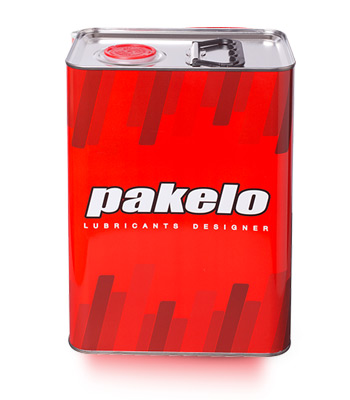SAE 15W/40

Product Specs
Product Code:
4286.18
Fields of Application:
Pakelo Golden Diesel Plus SAE 15W/40 is a high performance lubricant recommended for heavy duty Diesel engines (industrial, earth moving, building site machines, heavy trucks, buses, etc.) also under severe working conditions. The product has been formulated to satisfy the requirements of new generation low emission Diesel engines. It is also suitable for earlier generation Diesel engines. It can be adopted to extend oil drain intervals, with respect of Constructors’ recommendations and combined with a complete monitoring of oil in service through specific oil analyses. Take always into consideration correct oil drain intervals to obtain maximum engine life.
Since Pakelo Golden Diesel Plus SAE 15W/40 satisfies the severe Specifications ACEA A3/B4 and API SL for gasoline and light Diesel engines, it can be used for mixed vehicle fleets.
Levels of Performance:
ACEA E7, ACEA A3/B4, API CI-4 / CF, API SL, JASO DH-1, Global DHD-1, MB 228.3, MAN M3275-1, Volvo VDS-3, Renault Trucks RLD-2, MTU Type 2, Mack EO-M Plus, Caterpillar ECF-2 / ECF-1a, Cummins CES 20.078, Cummins CES 20.077 / CES 20.076, Deutz DQC III-10, Allison C4 / TES 439.
Approvals:
JASO DH-1.
“Global” multigrade lubricant for Diesel engines that satisfies American (API CI-4), European (ACEA E7) and Japanese (JASO DH-1) Requirements. Also suitable for gasoline engines.
Pakelo Golden Diesel Plus SAE 15W/40 is a multigrade lubricant developed for Diesel engines of latest generation. It is suitable for Heavy Duty and Light Duty Diesel engines of main world-wide Constructors. Thanks to its particular additive package, Pakelo Golden Diesel Plus SAE 15W/40 satisfies nearly all main world-wide specifications for Heavy Duty Diesel Engines (trucks, buses, earth moving machines, etc.): in particular the product satisfies the severe requests of American (API CI-4), European (ACEA E7) and Japanese (JASO DH-1) Specifications.
International OEMs are asked to design low emission engines in order to meet more and more severe American, European and Japanese standards regarding environmental pollution. Such low emissions engines usually produce higher quantity of soot and need lubricants with high dispersant properties which allow to maintain soot in suspension without changing of viscosimetric characteristic during service. To further improve the reduction of polluting emissions, mainly regarding the production of nitrogen oxides, specifications have been developed, such as the American API CI-4 and the European ACEA E7. One of the ways to reduce the production of such substances is the adoption of the EGR (Exhaust Gas Recirculation) system.
Through the EGR system, part (sometimes also significant) of exhaust gas is made to re-circulate in the combustion chamber. Acid particulate matter, carbon and nitrogen oxides are thus re-introduced in the combustion chamber. Such particles, by absorbing heat, decrease the maximum temperature that can be reached in the combustion chamber and as a consequence of this the total NOX formation is reduced. As a side-effect there is an increase of the soot produced in the combustion chamber and this means to require a further improvement in performance to the lubricant. In fact, tests made with the same lubricant on the same engines, one with EGR, have highlighted higher wear increase due to soot in the engine with EGR system.
API CI-4 lubricants used in engines with EGR enable to have the same protection and reliability as in engines without EGR. That means, when using API CI-4 lubricants for engines without EGR valve, there is higher protection if compared to lubricants that have not been studied for this application. This guarantees longer life and cleanness of engine. An alternative solution to reduce emissions is to use the SCR (Selective Catalytic Reduction) system.
In this case ammonia generated from urea, that comes from a specific tank, is injected into the exhaust gas over the catalyst to reduce the NOX to water and molecular nitrogen.
Sometimes, the joint use of particulate traps allows further emissions reduction. The American API CI-4, the European ACEA E7 and Japanese JASO DH-1 Specifications were designed for testing suitable lubricants for this kind of engines. In particular, lubricants that meet those Specifications have to pass the following tests: oxidation controls, aeration, viscosity loss in service, deposit on pistons, corrosion, oil thickening due to soot, wear of liners, pistons, rings, oil consumption, cleanness of filters, compatibility with gaskets, used oil pumpability.
Furthermore Pakelo Golden Diesel Plus SAE 15W/40 is suitable for low emission engines of the main Japanese Constructors, equipped with CRI system (Common Rail Injection) and with EGR valve. Products not suitable for those new technology Japanese engines, such as lubricants recommended for many years in the past and responding to overcome API CD/CF Specifications, on the contrary can lead to early wear of engine parts and reduction of engine life.
The particular formula of Pakelo Golden Diesel Plus SAE 15W/40 thus provides the following properties:
- good low temperature properties;
- high Viscosity Index to guarantee a low power absorbance due to viscosity resistance during start-up at low temperatures and high viscosity at high temperatures to guarantee a suitable lubrication film;
- excellent dispersant properties that guarantee a great control of sludge and oil thickening also in case of high presence of soot and deposits. These phenomena are typical of modern engines that work at higher temperature due to the use of EGR system;
- very high detergent properties that guarantee cleanliness performance and long drain intervals;
- low formation of lacquers and varnishes that form at low temperatures specially during “stop-and-go” service;
- high thermal-oxidative stability;
- low volatility;
- excellent wear control;
- anti-corrosive properties to guarantee protection from combustion acid products and moisture caused by combustion and ambient;
- anti-foam properties to reduce or to remove discontinuity of lubricant film caused by excessive formation of inner foam;
- good compatibility with gaskets;
- excellent pumpability at low temperatures of used oil too, to guarantee the presence of the lubricant for all the engine moving parts right from the first working periods.

